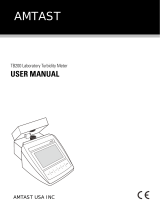
4.3 Calibration Standards
TN400 turbidity meter adopts US EPA certified Reagecon high molecular weight polymer
turbidity standard solution. Compared with traditional Formazin standard solution, Reagecon
standard solution has a lot of advantages, such as non-toxicity, high accuracy, long shelf-
life, traceable to NIST and so on. The standard solution supplied in the TN400 turbidity meter
kit has a shelf-life of 12 months (from the date of manufacture). Please check the date on
the bottom of the vials before using.
4.4 Calibration Notes
1) Place turbidity meter on a flat and level surface, and please do
not hold the instrument in hand.
2) When a calibration vial is placed into measuring well, the arrow
mark on vial cap must be aligned with the arrow mark on the
measuring well. See diagram-4
3) Apply little drop of silicone oil on the calibration vial and wipe
even with soft cloth to improve light scattering. Please don't apply
too much silicone oil, and the vial must be wipe and cleaned up. Otherwise it will affect
measuring accuracy. After wiping and cleaning, set the calibration vial still on the table
for at least 2 minutes to eliminate micro bubble in solution. For 0.02 NTU calibration vial,
the standing time should be at least 5 minutes.
4) If Formazin standard is used to calibrate, note the diluted Formazin standard is not
stable. Please make sure to use new prepared Formazin standard to ensure calibration
precision.
5) Please do not open the cap of calibration vial. Inspect the expiration of calibration
standard. Make sure the calibration vial free from dust, dirt, fingerprint and scratch.
6) Please use the same method to calibrate every time, and establish standard operating
procedures (SOPs).
5 TURBIDITY MEASUREMENT
5.1 Sample Vial Handling
1) There are 3 sample vials contained in the case, marked 1#, 2# and 3# on the cap and
bottom of the vial. Please note the number of sample vial should be same as that of vial
cap, and do not mix up. Please always use 1# sample vial to measure low turbidity less
than 5 NTU.
















